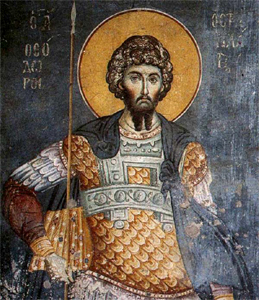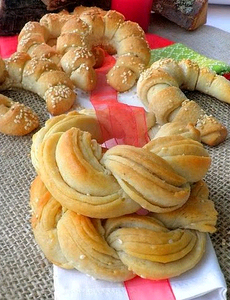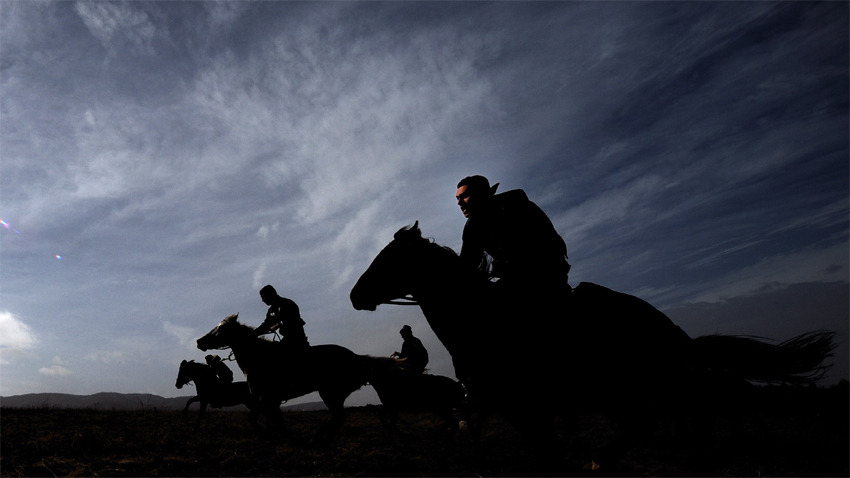 3
3
A major traditional feast day ushering in spring, St. Todor’s day is connected with the idea of fertility and fecundity. Historians say it has been celebrated in our lands since the early Middle Ages. For Bulgarians it combined the cult of two holy martyrs - Theodore Stratelates and Theodore Tiron.
 According to the Christian Orthodox calendar the first week of Great Lent is dedicated to Theodore Tiron, the Christian warrior saint who died the death of a martyr in 306. Fifty years after his death he appeared in a dream to the Archbishop of Constantinople, Eudoxius so to save his brethren from transgression. According to religious texts, Emperor Julian the Apostate (332 - 363) attempted time and again to revive pagan practices. During the first week of Great Lent he ordered blood from pagan sacrifices to be sprinkled on the food that was sold in the marketplace so Christians would break their fast without even knowing it, mocking them and calling them pagans. But his plan fell through. God intervened and Theodore Tiron appeared to the archbishop of Constantinople to tell him what the emperor had ordered so he could warn Christians to buy nothing from the market but make their own boiled wheat to eat throughout the week. Since that time, as a token of gratitude, St. Theodore Tiron is commemorated on the first Saturday of Great Lent. (The Christian Orthodox calendar has one more date devoted to the same saint – 17 February, with the day of St. Theodore Stratelates falling before that, on 8 February.)
According to the Christian Orthodox calendar the first week of Great Lent is dedicated to Theodore Tiron, the Christian warrior saint who died the death of a martyr in 306. Fifty years after his death he appeared in a dream to the Archbishop of Constantinople, Eudoxius so to save his brethren from transgression. According to religious texts, Emperor Julian the Apostate (332 - 363) attempted time and again to revive pagan practices. During the first week of Great Lent he ordered blood from pagan sacrifices to be sprinkled on the food that was sold in the marketplace so Christians would break their fast without even knowing it, mocking them and calling them pagans. But his plan fell through. God intervened and Theodore Tiron appeared to the archbishop of Constantinople to tell him what the emperor had ordered so he could warn Christians to buy nothing from the market but make their own boiled wheat to eat throughout the week. Since that time, as a token of gratitude, St. Theodore Tiron is commemorated on the first Saturday of Great Lent. (The Christian Orthodox calendar has one more date devoted to the same saint – 17 February, with the day of St. Theodore Stratelates falling before that, on 8 February.)
 In Bulgarian tradition, the rituals performed on the day of St. Todor are for health and fecundity in horses. The ritual loaves the young brides bake before sunup are shaped to resemble a colt or a horseshoe. On these loaves the women would put cloves of garlic, walnuts, maize grains and salt. The women would then give the bread out to friends and neighbours, at the same time imitating a horse’s whinny and canter – this was done so horses would propagate and young brides would beget babies throughout the year. Chunks of the ritual loaves were put into the horses’ feed. Boiled wheat, maize, peas and beans were also handed out. It was believed that St. Todor was the patron saint of horses and himself rode a white horse. He is also ascribed demonic characteristics – he is seen as a dead man re-incarnate who, together with other evil spirits, treads the Earth after sundown throughout St. Todor’s week (the first week after Cheesefare Sunday). To ward off evil that could befall them during the week preceding the day of St. Todor, people would observe rigid prohibitions which concerned most of all the household chores done by women or the “women’s work”, though the strict fast was for everyone.
In Bulgarian tradition, the rituals performed on the day of St. Todor are for health and fecundity in horses. The ritual loaves the young brides bake before sunup are shaped to resemble a colt or a horseshoe. On these loaves the women would put cloves of garlic, walnuts, maize grains and salt. The women would then give the bread out to friends and neighbours, at the same time imitating a horse’s whinny and canter – this was done so horses would propagate and young brides would beget babies throughout the year. Chunks of the ritual loaves were put into the horses’ feed. Boiled wheat, maize, peas and beans were also handed out. It was believed that St. Todor was the patron saint of horses and himself rode a white horse. He is also ascribed demonic characteristics – he is seen as a dead man re-incarnate who, together with other evil spirits, treads the Earth after sundown throughout St. Todor’s week (the first week after Cheesefare Sunday). To ward off evil that could befall them during the week preceding the day of St. Todor, people would observe rigid prohibitions which concerned most of all the household chores done by women or the “women’s work”, though the strict fast was for everyone.
To this day horse races are organized on the day of St. Todor known as kushia, tudoritsa, domle. Once the horse races were open to young unmarried men. Early in the morning, before the sun was up, the young men would take the horses to water, then give them bread and salt to eat and adorn them with beads, ribbons, flowers or strings of red peppers. In some parts, the party of young riders would pay visits to many of the households in the village where they would be treated to wine and buns. In other regions the young men would make three rounds of the cemetery, the church yard or the village square before the start of the races. But the happiest man on this day was the winner – he would win a prize but also earn the respect of the community for the prowess and skills he has shown.

St. Todor’s Sunday was the first day on which women were allowed to wash their hair – before or during the races - so their hair would grow as long and thick as a horse’s tail. They would pour the water they had washed their hair in into the street as horses passed by or would run after the riders, their hair wet. According to traditional belief, this was said to ward off headache, vertigo and insanity. To this day young brides receive symbolic gifts – boiled wheat, baby slings, shirts, distaffs. In many parts different rituals were performed for young brides’ fertility. This helped them cross over into a different social category – that of married women. Even now a qurban is given (sacrificial rite) called “horse saint” in honour of the patron saint of horses.
English version: Milena Daynova
The 14th World Folklore Championship, "World Folk 2024" , starts today and runs until August 30 at three locations on Bulgaria's Black Sea coast: Nessebar, Sunny Beach and Sveti Vlas. The event kicks off tonight at the Jana Chimbuleva Amphitheatre in the..
Esther Willems from the Netherlands continues to attract people from different cities and nationalities to her club for Bulgarian folk dances, established in The Hague and named "Zora". It was founded in 2017 and then 13 people..
In the middle of August in Kyustendil, Southwestern Bulgaria, the "Panagia - Raising of the Bread" holiday takes place. The holiday is directly related to the church holiday "Assumption of the Blessed Virgin Mary", marked on August..

+359 2 9336 661
